by Anne Beaudreau
University of Alaska students and faculty in the fisheries program kicked off spring with a science extravaganza for the public. Billed as UA Fisheries Days at Lena Point, the two-day event featured the 22nd Annual Student Research Symposium on Friday, April 6th, 2018, and a Fisheries Open House on Saturday, April 7th. The events were held at the Juneau Fisheries Center of the University of Alaska Fairbanks (UAF).
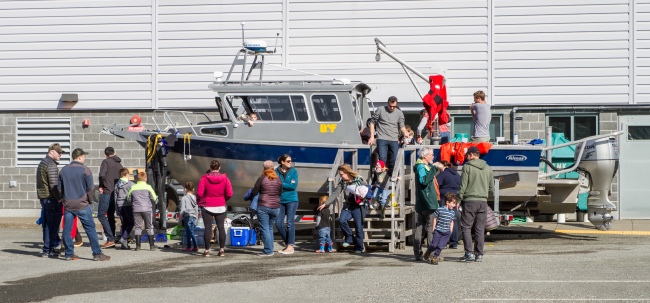
Kids and adults loved the opportunity to climb aboard our 27-foot research vessel, the R/V Ishkeen. Photo by Chris Sergeant.
Opening our doors to the public
To find UAF’s Juneau Fisheries Center, you head “out the road” away from downtown Juneau. You drive along the wetlands, past the populated Mendenhall valley, and on towards Auke Bay, which is your last chance for coffee and snacks before you head out along the last 30 miles of the Juneau road system. Plenty of Juneauites head out the road for a hike on a nice day, but not many visit our building on their way there. After all, we’re not very easy to find – our building is tucked away on Lena Point, out of the public eye, about 5 miles past Auke Bay.
The Juneau Center has been co-located with NOAA’s Auke Bay Laboratories on Lena Point since 2008, but our Saturday event was the very first open house for the public. One of our goals for the open house was to increase awareness of the UAF fisheries program within the broader Juneau community. Many of the people attending our open house said they hadn’t known about us and were thrilled to discover the extent of the fisheries research and education taking place in Juneau.
“I’ve always, always, always wondered what was out here,” one visitor said with excitement, “and now I know!”
Most Juneau residents we’ve talked to are surprised to learn that UAF has a presence here. In fact, there are around 10 faculty and 40-60 graduate students, depending on the year, based out of the Juneau Center. The Juneau Center moved from the University of Alaska Southeast (UAS) to UAF in 1987, when the School (now College) of Fisheries and Ocean Sciences was created1. To this day, we work closely with faculty and students at UAS, which is just down the road from our facility. UAS marine biology undergraduate students and faculty provided an incredible touch tank experience for the open house visitors.
1 https://www.uaf.edu/cfos/about-us/locations/juneau/
Sherry Tamone, a University of Alaska Southeast professor and joint faculty member at UAF, shows off the octopus to an eager crowd of visitors. The octopus was easily the star of the touch tanks! Photos by Gabrielle Hazelton (left) and Chris Sergeant (right).
Variety is the spice of life (and research)
The student research symposium on Friday featured talks by graduate students that highlighted the breadth of UA research on freshwater and marine ecosystems and its contributions to sustainable fisheries in Alaska. The student organizers in Juneau and Fairbanks provided a videoconference connection so that presenters and audience members could tune in from all parts of Alaska. The symposium drew around 70 attendees in Juneau and 20-30 in Fairbanks and other locations. It was sponsored by the Alaska Chapter of the American Fisheries Society, the St. Hubert Research Group, and the UAF College of Fisheries and Ocean Sciences (CFOS).

The 22nd annual student research symposium drew a good crowd in Juneau. Photo by Anne Beaudreau.
A striking aspect of the symposium was the diversity of research being done by fisheries students, faculty, and their colleagues from the Arctic to Southeast Alaska and beyond. Projects range from kelp aquaculture to public perceptions of whale watching, predator effects on young salmon to monitoring of rapidly changing rivers and coastal habitats. A cross section of the research was highlighted in a Juneau Empire article that promoted the symposium.
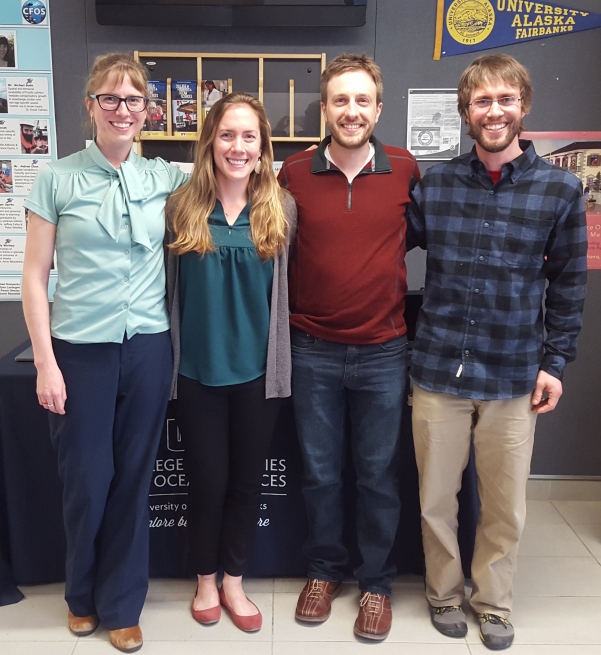
Several students won awards for their presentations. From left: April Rebert (1st place, Long Talk), Ali Schuler (3rd place, Long Talk), Justin Priest (Best Introduction), and Matt Callahan (1st place, Short Talk). Not pictured: Caitlin Forster (2nd place, Long Talk). Photo by Anne Beaudreau.
Something for everyone
Our open house on Saturday mirrored the diversity of research and interests that students showcased during the symposium. Nearly 500 visitors of all ages circulated to different activity stations that provided hands-on opportunities to explore the work we do in fisheries and ocean science. There was something for everyone, from toddlers to retirees.
In one of the labs, visitors learned about how we study the inner lives of fish, from determining their age using ear bones (otoliths) to uncovering clues about their nutrition from the contents of their stomachs. The How Old is That Fish? station wasn’t just about fish; our guests also learned about how researchers age crab and geoduck. (Hint: it’s all in the shell!) At the Diet Detectives station, kids got to do a bit of fish forensics by identifying “prey” (i.e., paper and pipe cleaner creatures) using dichotomous keys. Some of the kids loved the game so much that they identified every type of prey and, in one case, went through the whole process twice. Several parents were commercial fishermen who connected with the research, saying that they often look inside stomachs of fish to get clues about where, when, and how to target them.
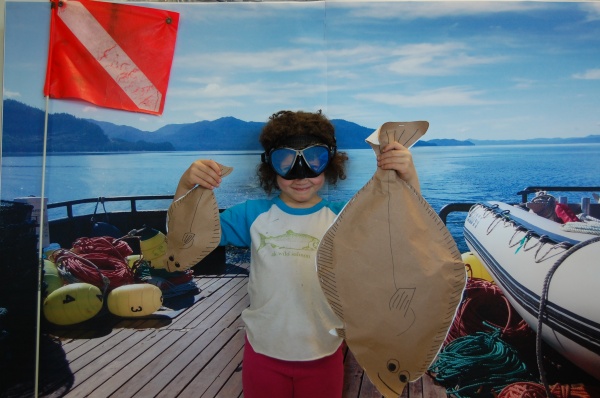
The photo booth was popular with kids and adults alike. Here, one of our guests showed off her catch of the day. Photo by Megan McPhee.
At the Marine Mammal Extravaganza station, there were many marine mammal pelts, baleen, teeth, and skulls to touch. Kids played a sea otter foraging activity game to learn about how otters use their sense of touch to find the right food. They also got to test their humpback whale identification skills, matching photos taken of humpback whale flukes with a Fluke ID Catalog. The Microscope Discovery station not only gave visitors the opportunity to view teeny tiny Arctic cod otoliths and baby crabs under the microscope, but guests could also take a photo through the scope and create a customized button from the image!

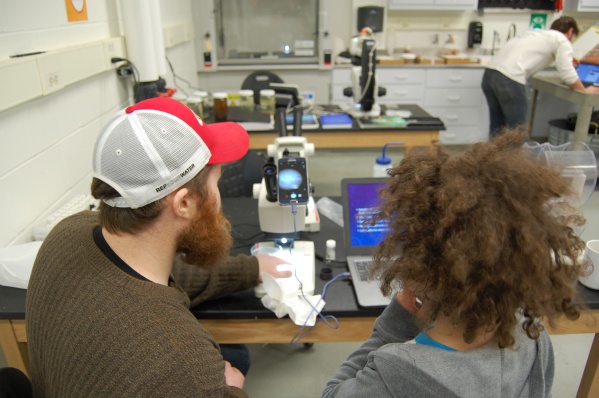
- Graduate students shared their knowledge of creatures great and small: Jenell Larsen presented some marine mammal skulls (top) and Zane Chapman provided a close-up view of baby crabs (bottom). Photos by Chris Sergeant (top) and Megan McPhee (bottom).
Meanwhile, on the second floor an intense computer game called So You Want to be a Salmon Manager? was underway in which participants were tasked with managing a salmon fishery in real time. Down the hall, at The Crazy Life of Kelp, the public learned about and saw every stage of the amazing life cycle of kelp, from live swimming spores to mature kelps. Master’s student Annie Thomson, who led the activity, said that a family who visited had one child who was thrilled by the kelp station and another who would not leave the salmon management game. “It was really cool to have so much diversity in activities,” Annie said. “There really was something for everyone!”

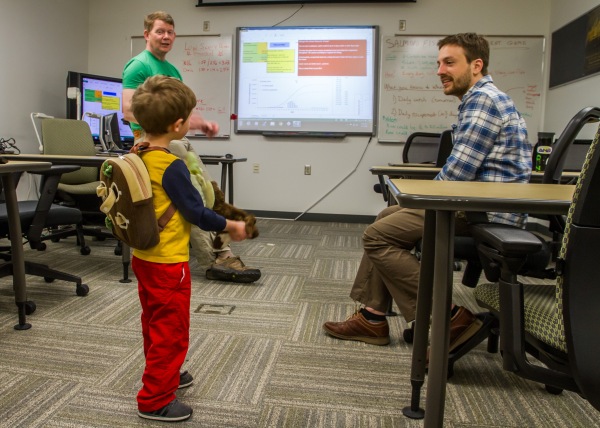
- Young learners explore the tiniest life stages of kelp (top) and try their hand at salmon management (bottom). Photos by Megan McPhee (top) and Chris Sergeant (bottom).
We lucked out with a beautiful bluebird day, which enticed people to explore the outdoor Science Show-and-Tell station, where they got to test out and try on the tools of marine ecology. Visitors toured the R/V Ishkeen, our 27-foot research boat, and learned how to measure temperature and salinity off the side of the vessel. A few brave kids donned SCUBA masks and dunked their heads in a tank of cold water.
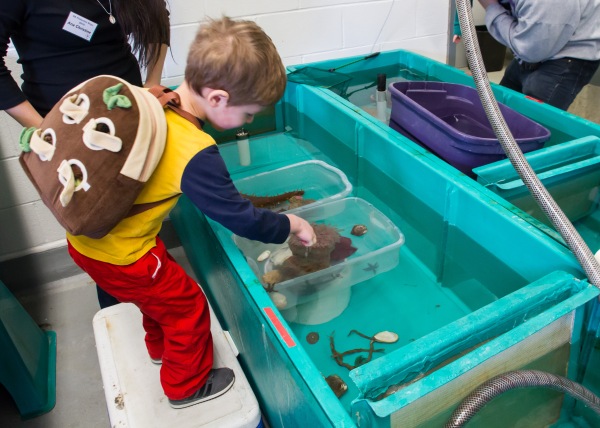
- One of the most popular activities was the touch tank station, where people had an opportunity to get up close and personal with some very brave marine invertebrates. My son James especially loved the “sticky anemone.” Photo by Chris Sergeant.
When our guests needed a break, they could enjoy a snack and watch a slideshow of our adventures in the field and lab. The younger crowd had lots of opportunities to get creative by coloring and creating their own humpback whale fluke patterns.
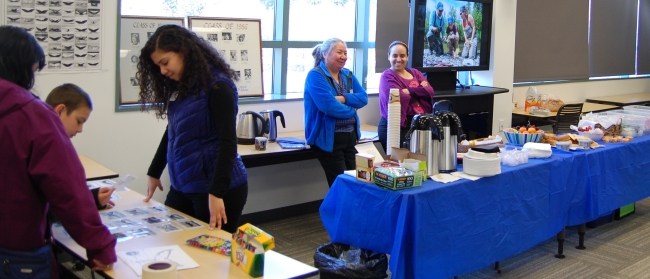
Angie Steeves and Judith Rosellon Druker kept everyone refreshed with snacks aplenty. At one point, we nearly ran out of food and our administrative manager Gabrielle Hazelton made a heroic grocery store run to replenish provisions. Photo by Megan McPhee.
My job was arguably the most fun, because I stationed myself at the table in the front lobby and got a chance to welcome every guest and hand out bookmarks, pens, magnets, and other fun CFOS items. Some of the kids reported back to me about their favorite experiences: “The octopus!”, “The salmon management game – there were 8 million salmon and I’m on the leaderboard!”, “Microscopes – I had no idea that crabs started out looking like that!” One of the parents said to me as she pointed to her young son, “I’m probably more excited than he is!” Needless to say, I got to witness a lot of excitement from kids and adults alike and more crushed Goldfish crackers on the lobby floor than I thought was possible.

Associate professor Anne Beaudreau (left) and Master’s student Ashley Bolwerk (right) took a lead role in coordinating the open house. Photo courtesy of CFE Lab.
Connecting through science
This was truly an “all hands on deck” effort—undergraduate and graduate students, postdocs, staff, faculty, and volunteers worked together to make our inaugural open house a success. Every member of our Juneau CFOS community who was able to participate contributed their creativity, energy, time, and excitement to the day. But, as many of us experienced that day, outreach is not just about giving your time and energy; you get as much as you give, if not more.
Rhea Ehresmann, who is completing her Master’s degree while working at the Alaska Department of Fish and Game, explained it best:
“My normal work duties involve lots of tense and stressful conversations with fishermen and the public as restrictions are being implemented for fisheries. I forgot how wonderful it is to interact with kids and people who have a genuine interest in our fishes, oceans, and science that we do. I’m pretty sure I left the open house feeling as inspired and filled with positive energy as many of those who attended. It was a great opportunity to share what we do, why we do it, and how we do it with the public.”
Thinking about all those happy kids, grateful parents, and an energized fisheries community, I agree wholeheartedly. We can’t wait to do it again in April 2020!
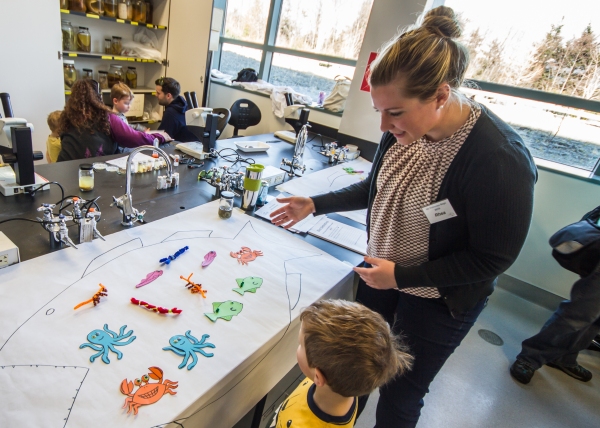
Rhea Ehresmann teaches the next generation of scientists how to identify what’s in a fish’s stomach. Photo by Chris Sergeant.
—
Thanks to the entire UA fisheries community for sharing their photos and experiences, which helped shape this story.


